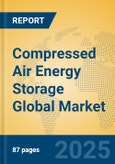Industry Characteristics
CAES systems store energy by compressing air, which is later expanded through turbines to generate electricity, achieving efficiencies up to 70% in advanced adiabatic systems. The industry is characterized by high capital costs and long project timelines, requiring geological suitability and engineering expertise. Like antioxidants stabilizing materials, CAES stabilizes grids by storing excess renewable energy, mitigating curtailment. Innovations focus on adiabatic systems that retain heat during compression, boosting efficiency, and small-scale modular designs for broader applicability. The market is driven by global renewable targets, grid reliability needs, and declining costs of renewable generation, though competition from batteries and pumped hydro poses challenges.Regional Market Trends
Growth reflects regional renewable penetration and grid infrastructure.- North America: The market projects a 3.0%-7.0% CAGR. The U.S. leads with projects in California and Texas, leveraging shale gas reservoirs. Canada focuses on hybrid wind-CAES systems.
- Europe: Europe anticipates a 3.5%-7.5% CAGR. Germany and the UK drive adoption through renewable integration policies, with projects exploring adiabatic CAES for efficiency.
- Asia-Pacific (APAC): APAC expects a 4.0%-8.0% CAGR. China’s renewable expansion and Australia’s grid stability needs drive growth. Japan explores small-scale CAES for island grids.
- Latin America: Growth is projected at 2.5%-6.5%. Brazil and Chile leverage CAES for renewable-rich grids, though financing constraints limit scale.
- Middle East and Africa (MEA): MEA projects a 3.0%-7.0% CAGR. The UAE and South Africa explore CAES for solar integration, with geological surveys supporting project feasibility.
Application Analysis
Applications include Grid Management and Renewable Energy Integration.- Grid Management: With a 3.0%-7.5% CAGR, this segment stabilizes grids by providing peak shaving and frequency regulation. Trends include AI-driven dispatch optimization.
- Renewable Energy Integration: Growing at 3.5%-8.0%, this segment stores wind and solar energy, with trends toward hybrid systems for continuous power.
Company Landscape
Key players focus on technology and project development.- Hydrostor Inc.: A leader in adiabatic CAES, Hydrostor deploys projects globally, emphasizing scalability.
- Siemens AG: Siemens provides turbine solutions for CAES, integrating digital controls.
- General Electric: GE’s turbines support CAES, focusing on renewable integration.
- ABB Ltd.: ABB offers automation and grid integration for CAES projects.
- Mitsubishi Heavy Industries: Mitsubishi develops high-efficiency turbines for CAES.
Industry Value Chain Analysis
The value chain includes geological assessments, compressor and turbine manufacturing, and grid integration. Upstream, site selection ensures reservoir suitability. Manufacturing involves precision engineering for turbines and heat recovery systems. Distribution includes EPC contractors, while downstream utilities deploy CAES for grid services. The chain emphasizes efficiency and environmental compliance.Opportunities and Challenges
Opportunities include renewable energy growth, grid modernization, and adiabatic technology advancements. Challenges encompass high capital costs, geological limitations, and competition from battery storage.This product will be delivered within 1-3 business days.
Table of Contents
Companies Mentioned
- Hydrostor Inc.
- LightSail Energy
- GE
- Ansaldo Energia
- Altairnano
- Bright Energy Storage Technologies
- ABB Ltd.
- Siemens AG
- General Electric
- Mitsubishi Heavy Industries








